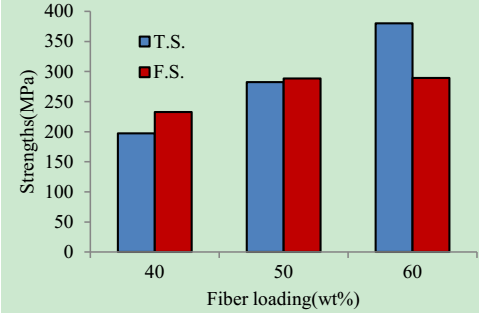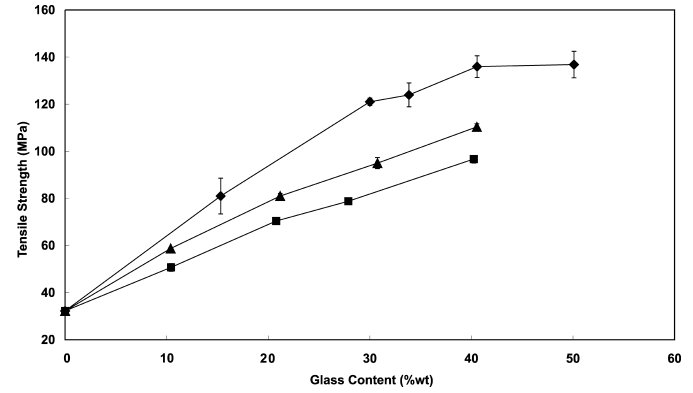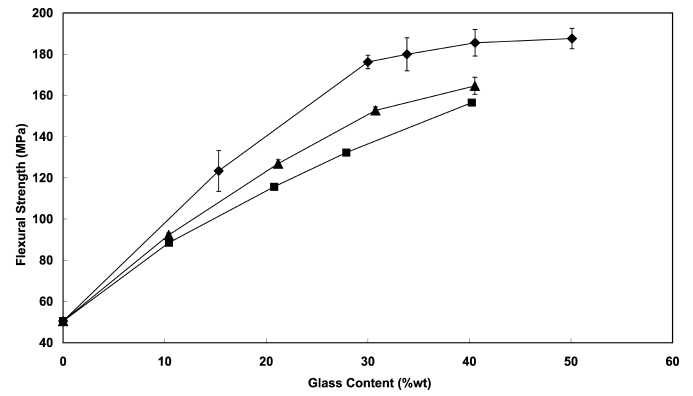-
Paper Information
- Next Paper
- Paper Submission
-
Journal Information
- About This Journal
- Editorial Board
- Current Issue
- Archive
- Author Guidelines
- Contact Us
American Journal of Materials Science
p-ISSN: 2162-9382 e-ISSN: 2162-8424
2016; 6(4A): 1-5
doi:10.5923/c.materials.201601.01

Significance of the Type of Reinforcement on the Mechanical Behavior of Polymeric Composites
Sridhar D. R.1, Varadarajan Y. S.2
1Department of Mechanical Engineering, MITE, Moodbidri, India
2Department of Industrial Production Engineering, NIE, Mysore, India
Correspondence to: Sridhar D. R., Department of Mechanical Engineering, MITE, Moodbidri, India.
| Email: |  |
Copyright © 2016 Scientific & Academic Publishing. All Rights Reserved.
This work is licensed under the Creative Commons Attribution International License (CC BY).
http://creativecommons.org/licenses/by/4.0/

The mechanical behavior of fiber reinforced polymer composites are influenced by various parameters. This article presents a comprehensive literature review on the effect of different parameters on the mechanical behavior of synthetic fiber reinforced polymer composites. From the review, it is found that the fiber orientation, type, volume fraction, interfacial adhesion and physical properties significantly affect the mechanical behavior of polymer composites. To develop high performance polymer composites, it is necessary to have some basic understanding of, effect of these parameters on mechanical behavior of polymer composites.
Keywords: Polymeric composites, Synthetic fibres, Mechanical behaviour, Thermoset, Thermoplastic, Reinforcement
Cite this paper: Sridhar D. R., Varadarajan Y. S., Significance of the Type of Reinforcement on the Mechanical Behavior of Polymeric Composites, American Journal of Materials Science, Vol. 6 No. 4A, 2016, pp. 1-5. doi: 10.5923/c.materials.201601.01.
Article Outline
1. Introduction
- Polymer matrix composites (PMCs) are finding increasing applications in automotive, aerospace, machine elements, chemical industry and many other areas as structural materials. In many of these applications, the composites are subjected to complex mechanical forces such as tensile, compression, bending, impact etc, where high strength of composites plays an important role. Many researchers have developed a variety of polymeric composites reinforced with different types of fibers and matrix materials to improve the mechanical properties of the same. The end properties of composites depend not only on the type of matrix and fiber material, but also on such parameters as fiber orientation, volume fraction, interfacial adhesion, fiber type, physical properties, etc. In the present paper, various reported works on mechanical behavior of synthetic fiber reinforced polymer matrix composites are reviewed and conclusions are drawn based on collected data.
2. Mechanical Behavior of Polymer Composites
2.1. Effect of Interfacial Adhesion of Fiber/Matrix on Mechanical Properties
- Mechanical properties of composites primarily depend on the fiber and matrix properties. However, the fiber/matrix interface also plays an important role in controlling some of the mechanical properties of composites, such as interlaminar shear strength and impact strength. A strong interface can transfer the load efficiently from the matrix to the fiber, resulting in stronger composite. Better interfacial adhesion can enhance composite transverse properties, flexural properties and interlaminar shear strength and so on [1, 2]. To improve the interfacial adhesion and wettability of composites, several surface treatment techniques are used such as electrochemical or wet chemical, oxidation, plasma treatment gas-phase oxidation etc., [3, 4]. Several researches have attempted to study the influence of the type and concentration of chemical solution and modified polymer matrix on the fiber characteristics and their interfacial adhesion. Y. Luo et al. [1] studied the wettability property of carbon fiber with different sizing or without sizing. The results revealed that surface characteristics of carbon fiber significantly changed after sizing. Analysis on dynamic contact angle indicated that sized carbon fibers had a lower total surface energy compared with the un sized one. It is also found that surface roughness, surface active functional groups and surface energy are of great importance for adhesion of carbon fiber/matrix interface. The main role of sizing was not to increase the interfacial adhesion between fiber and matrix, and the sizing for carbon fiber could serve as lubricant to prevent fiber damage during subsequent textile processing such as weaving and prepreg processing. Ping Chen et al. [2] analyzed the influence of fiber wettability on the interfacial adhesion of continuous fiber-reinforced PPESK composites. Results showed that fiber wettability has a strong influence on composite mechanical performance; surface free energy of carbon fiber and aramid fiber is higher than that of glass fiber. Higher surface free energy can enhance the wettability between matrix and fiber and reduces interfacial flaws. Interfacial adhesion can be improved at the same time. They found that the primary failure mechanism of carbon and aramid fiber composite is matrix failure and with glass fiber composite, it is interfacial failure. So the improvement of fiber wettability is a convenient way of improving the mechanical performance of polymer composites. Z. Xu et al. [3] investigated the wettability of carbon fiber modified by acrylic acid and interface properties of carbon fiber/epoxy. They found that when compared with the original carbon fiber, the surface of the modified fiber become rougher and more pieces of tiny fragments stuck to the fiber surface. Following the treatment, there was an increase of oxygen content on fiber surface, surface energy and ester functional groups. The carbon fiber modified by acrylic acid enhanced the wettability and adsorption ability of the same in epoxy solution; tensile strength of carbon fiber was improved marginally are shown in Fig. 1.
 | Figure 1. Effect of surface modification on ILSS of CF/epoxy composites. Adopted from [3] |
2.2. Effect of Orientation of Fiber on Mechanical Properties
- In fiber polymer composites, fiber acts as carrier of load and stress under loading conditions. Therefore, orientation of fibers will have significant effect and play an important role in controlling the mechanical properties of the same. Fiber reinforced composites show strong anisotropic mechanical behavior due to their fiber orientation. These orientations cause a variety of failures which are more complex under multi axial loading conditions. Many researchers have studied the effect of fiber orientation on mechanical properties of polymer composites. It has been reported that increase in fiber orientation angle deteriorated the mechanical properties. The fiber reinforcement in 0° (parallel to the loading direction) enhanced all the strength and modulus properties significantly. The parallel fiber orientation delivers better compression modulus and compression strength as compared to perpendicular fiber orientation [6] are shown in fig.2. The tensile strength is affected by the fiber orientation significantly; the ultimate tensile strength and young’s modulus was higher at 90° fiber orientation [7]. Ultimate tensile strength, young’s modulus, flexural modulus and flexural stress values increased at 30° fiber orientation as compared to 45° and 60° orientations [8].
 | Figure 2. (a) Composite modulus (b) Compression strength for three different investigated materials. Adopted from [6] |
2.3. Effect of Volume Fraction/Fiber Content on Mechanical Properties
- The fiber volume fraction or fiber content significantly affect on mechanical properties of polymer composites. Many researchers have investigated the effect of fiber content on mechanical properties of polymer composites. V.K. Srivasta et al. [9] investigated the mechanical behavior of copper and aluminum particle reinforced epoxy resin composites. This study revealed that, the tensile strength of particle filled composites degraded with increase in fiber content. Increased filler content increased compressive strength and hardness of the composites.Sriram et al. [10] investigated the effect of silicon and graphite fillers on mechanical behavior of epoxy composite laminates; the result showed that the mechanical properties of the composites mainly depend on dispersion condition of fiber particles and aggregate structure. The properties of composites improved in tensile strength, flexural strength, Impact strength and hardness with increase in silica filler content, but hardness decreased by increased content of graphite filler.S.P Borkar et al. [11] investigated the effect of adding silica and calcium carbonate fillers on the properties of woven glass fiber composites. They found that the increased filler concentration increased the tensile strength and impact strength decreased for both the type of fillers. It is also observed that increase in filler content decreased the ductility of the composites. The flexural strength for all the filler samples increased with increasing filler concentration.P. Amulthakannan et al. [12] investigated the effect of fiber length and fiber content on mechanical properties of short basalt fiber reinforced polymer matrix composites. The characterization of the composites revealed that fiber content has significant effect on mechanical properties of composites. The tensile strength and impact strength were enhanced at 68% fiber content.S.R Chauhan et al. [13] studied the effect of fiber loading on mechanical properties, friction and wear behavior of composites under dry and water lubricated conditions. He reported that the tensile strength and tensile modulus and elongation have improved at 60% of fiber loading, but there is a reduction in these properties when fiber content increased above 60%, are shown in fig.3.
 | Figure 3. Variation of strength for three different composites. Adopted from [13] |
2.4. Effect of Physical Properties of the Fiber on Mechanical Properties
- The mechanical properties of fiber reinforced composites can be enhanced by reinforcing with various lengths, diameter of fibers and size of particulates; these parameters have a significant influence on the mechanical properties of polymer composites. It has been reported by many researchers. S.Y. Fu et al. [15] investigated the tensile properties of short-glass-fiber and short-carbon-fiber-reinforced polypropylene composites. It was observed that mean glass and carbon fiber length decreased with increasing fiber volume fractions and combined effect of fiber volume fraction and length determines the final tensile properties of the composites. It has been shown that the composite strength is more depended on mean fiber length or mean fiber aspect ratio than on fiber volume fraction, while the composite modulus is more dependent on fiber volume fraction than mean fiber length. J.L. Thomson et al. [16] studied the influence of fiber length and concentration on the properties of long and short glass fiber (LF & SF) reinforced polypropylene (PP) processed by Injection molding. The results revealed that comparison of mechanical performance of LF-PP against SF-PP for the same fiber diameter over a range of fiber contents, it is found that LF-PP showed significant improvement in tensile and flexural strength, are shown in fig 4 and 5. The improvement in impact resistance is even higher at lower test temperature. The effect of lowering the fiber diameter increased the strength of SF-PP (both the strength and un-notched impact resistance), but not to the level obtained with LF-PP at higher fiber diameter. The composite strength was shown to be strongly dependent on fiber aspect ratio and IFSS.
 | Figure 4. Tensile strength versus fiber content (♦ LF19, ■SF19, ▲SF14) Adopted from [16] |
 | Figure 5. Flexural strength versus fiber content (♦ LF19, ■SF19, ▲SF14) Adopted from [16] |
- Mohammad Bagher Rezvani et al. [17] evaluated the effect of fiber diameter on flexural properties of fiber-reinforced composites. Results of this study revealed that the flexural strength of fiber reinforced composites increased with increasing fiber diameter; the elastic modulus also showed the same trend up to 19µm. The fiber with smaller diameter provided larger surface area and consequently more defects on the interface appear along with the fiber clustering which results in lower flexural strength and modulus.P. Amuthakannan et al. [18] investigated the effect of fiber length and fiber content on mechanical properties of short basalt fiber reinforced polymer matrix composites. He conducted experiments on 4, 10, 21 and 50 mm fiber length and 10 to 80% vol. of fiber content. The results revealed that composite with 10 mm fiber length and 80% vol. fiber content exhibited better performance than other lengths with reference to flexural and tensile strength. The composite with 50 mm fiber length showed better impact energy absorption for all the percentage of fiber content. This showed that fiber length and fiber content have significant effect on the mechanical properties of polymer composites.
3. Conclusions
- In this article, several reported works on mechanical behavior of fiber reinforced polymer composites have been reviewed. The important observations are as follows:The interfacial adhesion between fiber/matrix is strongly depended on surface roughness, surface active functional groups and surface free energy of fiber. These parameters vary with different fiber material. Interfacial adhesion could be optimized, not necessarily maximized by effective utilization of fiber strength. Composites with optimal interfacial adhesion exhibit good mechanical properties. Adhesion between fiber/matrix interfaces could be enhanced with suitable fiber treatment methods.The increase in fiber orientation angle deteriorated the mechanical properties. The fiber reinforcement in 0° (parallel to the loading direction) enhanced all strength and modulus properties significantly.The mechanical properties of composites improved with higher fiber content up to a particular range, but further increase in fiber content showed reduction in mechanical properties. This is attributed to increased fiber-fiber contact decreased the interaction between fiber and matrix. The mechanical properties of the particulate reinforced polymer composites mainly depend on dispersion condition of filler particles and aggregate structure; increase in filler content decreased the ductility of the composites and there was a decreased availability of matrix material to bond all the particulates.It has been shown that the composite strength is more depended on mean fiber length or mean fiber aspect ratio and IFSS than on fiber volume fraction, while the composite modulus is more depended on fiber volume fraction than mean fiber length. These combined effects of mean fiber length and fiber volume fraction determines the final strength of the composites.
 Abstract
Abstract Reference
Reference Full-Text PDF
Full-Text PDF Full-text HTML
Full-text HTML